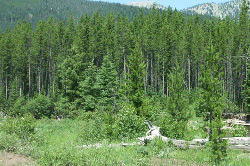Timber and Logging
Updated: August 13, 2020

What do you think of when you first hear the word ‘timber’? What about ‘logging’? Do you think of forest fires? Chopping axes? The Forest Service? Quaint log cabins? Sparkling Christmas trees? A burly bearded man, sawing determinedly and then triumphantly yelling “TIIMMMBBERR”?
Timber is a noun, defined as ‘the wood of growing trees suitable for structural uses’ ‘Wooded land’ or ‘wood, especially when suitable or adapted for various building purposes.’
Logging is also a noun. It’s defined as ‘the process, work, or business of cutting down trees and transporting the logs to sawmills’.
As for Christmas trees, the number of trees harvested in Montana in 2017 was 17,014 trees out of the 15,094,678 harvested trees in the United States. Montana had 1,530 acres of Christmas tress out of 321,000 acres nationally. Montana had 100 farms out of 30,502 nationally. Some farms are in Missoula, Victor, Polson, Lewistown, Kalispell and Trout Creek.

According to the Montana Forests website, more than 5,000 wood and paper products make our lives better each day. Chances are you ate some wood today, wore it, and brushed your teeth with it. Everything form baby food to rayon to toothpaste to football helmets and diapers are made from trees.
Homes, furniture, and paper are products we associate with the forests, but there are thousands more. Aspirin and other medicines, film, plastics, paints, computer parts, shoe polish, and charcoal are just a few of the products that come from our forests.
Each Montanan uses about 600 pounds of paper each year, according to statistics, and this demand is expected to double by the year 2030.
Every week the Sunday "New York Times" uses enough paper to equal 75,000 trees that are eight inches in diameter at the base. In a year, "The Missoulian" utilizes the paper from more than 28,000 such trees. I wonder how much of that gets recycled...
In 1869, a small number of sawmills in Montana produced about 13 million board feet lumber.
In 2005, Montana produced 1,001 million board feet lumber according to Western Wood Products Association.
If you want to work as a logger when you grow up, you can call yourself a timber/forest products worker, a timber yard worker, timber mill worker, or a sawmill hand.

According to Montana Wood Products Association, Montana had over 8.8 million acres of nonreserved timberland in 2019. In 1990, the forest products industry in Montana had sales of $900 million to 1 billion. Wow!
The Forest Products Industry, Montana's Living Heritage tells that the first known sawmill in Montana was built by a Jesuit priest, Father Anthony Ravalli, at present-day Stevensville in 1845.
The forest products industry provides 45% of the economic base of Western Montana and 15% of Montana's economic base. Fun Forest Facts About Montana. Between 1990 and 1995, Montana's forest products industry accounted for 15% of basis industry labor income and 10% of the state's basic employment. Forest products manufacturing ranks third, after the federal government and agriculture, and more than 80% of forest industry labor income and employment is concentrated in western Montana counties.
What about forest fires? Not to worry. Historically, fire has had a significant role in maintaining healthy forests. Fire kept dangerous fuel in the form of dead trees, needles and other forest litter in check. At the same time, fire helped manage the age class distribution of our forests in a healthy state, killing some of the old and weak trees, and providing seed beds for regenerating new trees. Fire managed tree density, thinning stands to maintain optimal growing space. Fire also determines tree species composition on a site. Some tree species such as Ponderosa and Lodgepole pines are dependant on fire for their survival. However, fire to man is a scary, dangerous thing that we have historically attempted to eliminate. Since the turn of the century, fire has been considered to be the enemy of the forest and we followed a policy of suppression. The result is fuels built up, trees became sick and crowded. Today our forests are full of dead, sick, and crowded trees, the very trees that Mother Nature would have used fire to eliminate. Responsible forest management, including prescribed fire, fuels reduction and commercial timber harvest can replicate many of the effects of natural fire. We can restore our forests to more natural and healthy states, protect our homes and communities from fire, and produce valuable wood products, jobs and healthy economies.
Want more information? Visit the United States Department of Agriculture, Natural Resources Conservation Service at: Natural Resources Conservation Service.
There’s also the mt.gov website, Department of Natural Resources & Conservation, Forestry Division at Forestry Division.
You can visit the Montana Forests website at the Montana Wood Products Association.
Thanks for visiting the Montana Kids' Site! We hope you've found the information both educational and entertaining. If you have comments or suggestions on ways we can improve the site please send us email at montanakids@visitmt.com.
You can also help your family plan a trip to Montana. Have your folks request a statewide travel packet by sending their mailing address to travelinfo@visitmt.com.

